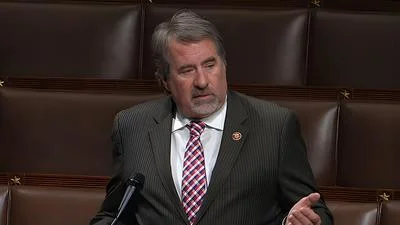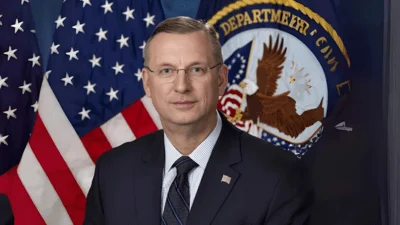Thank you, Greta, for that kind introduction. And thank you for all that you are doing to assist Ukraine and our partners around the world.
For those of you I haven’t met, my name is Jessica Lewis, and I am the Assistant Secretary of State for the Bureau of Political-Military Affairs, or PM. We are the bureau delivering security assistance to countries like Ukraine to strengthen our security partnerships around the world.
As we gather here today, we’re approaching the one-year mark since Russia launched its full-scale invasion of Ukraine. Putin’s aggression has cast a long shadow across Eastern Europe and the world, spurring countries around the globe to increase defense spending and create new security arrangements. The Middle East and Africa continue to face challenges from terrorism, fragile governance, and violent insurgencies. And in the Indo-Pacific, a restless and increasingly confrontational People’s Republic of China, or PRC, gives its neighbors pause.
So, as you can tell, we have our hands full.
The future of the free and democratic world rests on our collective shoulders. To preserve the rules-based order that, in the aftermath of World War II, enabled unprecedented global economic growth, international recognition of basic human rights and the expansion of democracy, we need to work together to strengthen our alliances, forge new partnerships, and identify new ways for us to work together.
The road to renewing and reimagining our alliances runs through the State Department, and arms sales and defense transfers are integral to these relationships. Rising threats around the world have led countries to increase their purchases of U.S. defense articles to keep their people safe.
We saw this in 2022, as the three-year combined average in arms sales increased by over 26% to $153.1 billion. And for those of you who’d like more detail on these statistics, please see our new fact sheet on the PM website.
This historic increase in arms sales was fueled, in part, through our provision of security assistance. Security assistance greases the wheels of these security partnerships, furthering our national security while strengthening our bilateral relationships.
Today, I’d like to talk to you about how in this moment of tectonic change we are providing security sector assistance to build resilient, effective partnerships that are responsive to these increasing threats, and how by reinvigorating our defense industrial base, we can sustain these relationships for the future.
The Big Picture
I’d like to start with the big picture. Now, with the changing face of national security, our provision of security assistance is also evolving.
Russia’s invasion of Ukraine
This pivotal moment is being driven by, more than anything else, the acute threat posed by Russia’s brutal and unprovoked invasion of Ukraine. Putin’s war has pummeled Ukraine’s cities, sent millions of refugees throughout Europe and has destabilized the global economy. The Government of Ukraine estimates landmines and unexploded ordnance may cover 26 percent of its territory, an area larger than Illinois. After decades of peace, Europe is again at war.
Since Russia launched its full-scale invasion in February 2022, we have provided nearly $27 billion in military assistance to Ukraine. Security assistance is at the heart of America’s response, and we will continue to calibrate our assistance to align with Ukraine’s current and future defense needs. And my bureau, PM, has been at the forefront of this effort.
We have used Presidential Drawdown Authority, or PDA, to transfer DoD inventory directly to the Ukrainian military. Some Administrations may go their entire tenure without invoking PDA authority to respond to a crisis. In less than two years, we processed 30. Further, the historical cap for PDA was $100 million. In 2022, Congress increased the cap by more than 15,000 percent as a result of Russia’s invasion of Ukraine.
Congress also increased appropriations for Foreign Military Financing by over 1,365 percent, providing more than $4.8 billion for Ukraine and countries impacted by the situation in Ukraine to help these countries meet their rising defense requirements posed by Russia’s aggression.
While Russia is busy targeting schools, hospitals, and power stations, we have increased funding for humanitarian demining and conventional weapons destruction from $6 million to $91.5 million to increase capacity and protect civilians. We expect this to increase significantly under the most recent supplemental appropriation.
And we are not alone – our Allies and partners have stepped up to help Ukraine defend its sovereignty and territorial integrity.
Earlier this month, I was with Deputy Secretary of State Wendy Sherman and Under Secretary of Defense Colin Kahl in Europe. We saw firsthand the incredible work being done as the world unites to get weapons to Ukraine, and we stand shoulder-to-shoulder with the international coalition of more than 50 countries to assist Ukraine in its darkest hour.
Russia’s invasion has global ramifications beyond Ukraine or even Europe. It is an attack on our shared values and the rules-based international order. To put it simply, the outcome of this war will shape the future of global security.
If Russia can invade its sovereign, democratic neighbor with impunity, it sets a precedent that others can reshape the global order and borders by force without suffering consequences.
By delivering the largest security assistance package in a generation, we are sending a clear message to any country that seeks to pursue aggression. Our security assistance is a vital investment in democracy and as a hedge against autocracy.
The pacing challenge of the PRC
As we work to address Russia’s revanchist challenge in the West, we are also paying close attention to the challenge posed by the PRC.
Now, much ink has been spilled about the rise of the China and what it means for the world. As Secretary Blinken has stated, it is the only country with the power and the intent to seriously challenge the stable and open international system. We are seeing this as the PRC tightens the screws on Taiwan, conducts live-fire naval exercises in the South and East China Seas, and engages in border clashes with India.
Let me be clear – we do not seek to contain China, nor do we seek conflict. As Secretary Blinken has said, we’ll compete with confidence; we’ll cooperate wherever we can; and we’ll contest where we must. To preserve peace and security, we must strengthen deterrence to make diplomacy possible.
Just a few days ago, I was in Hawaii at INDOPACOM, speaking with leaders across the Departments of State and Defense to identify ways for us to strengthen our security across the Indo-Pacific. Time and again, our discussions returned to one key point: nothing is as important as nurturing relationships with our allies. Together, we must leverage America’s greatest strength – the ability to build coalitions, founded on common cause and common values, to advance our vision of a free, open, democratic, and interconnected world.
To manage the pacing challenge of the PRC, we are bolstering security sector assistance in the Indo-Pacific.
For example, across the Indo-Pacific region, we provided over $270 million in bilateral, regional, and global Foreign Military Financing in FY 2022 to help longstanding Allies and partners purchase U.S. defense articles.
Through the Global Defense Reform Program, we are providing advisory support for islands throughout the Pacific to strengthen maritime governance, counter illicit maritime activities, and safeguard the free flow of commerce.
We are also leveraging humanitarian demining assistance across the region to remove explosive ordnance, protect civilians, and strengthen bilateral relationships.
As a global leader in peacekeeping, we programmed over $30 million in peacekeeping-specific capacity building assistance for multiple Indo-Pacific partners in fiscal year 2022, including partnering with Indonesia and Malaysia to conduct recent multinational peacekeeping exercises.
And one month ago, Congress authorized new security cooperation tools to support Taiwan’s self-defense capabilities. Separately, since 2010, we have notified Congress of over $37 billion in arms sales to strengthen Taiwan’s self-defense capacity, deter aggression, and preserve peace, stability, and prosperity in the Strait and the broader region.
All of these efforts are part and parcel of a larger vision – strengthening our unmatched network of alliances and partnerships by tailoring our defense offerings and policies to diverse needs across the region. This holistic approach has enabled us to reinforce our longstanding alliances, foster security ties between our allies and partners through AUKUS and the Quad, and plant the seeds for future security partnerships.
Where are we going?
Now that I’ve told you what we are doing, I want to lay out where we are going – and how all of us, in the worlds of diplomacy, defense, and the private sector, need to work together to advance our national security.
In this moment of tectonic change, we are rethinking how we build security partnerships. But what is shaping the future of security assistance?
Transitioning off Russian equipment
The most important development driving change in the world of security assistance is Russia’s unconscionable war against Ukraine. Russia’s invasion has disrupted global defense trade and upended existing security arrangements.
Countries around the world which employ Russian systems are witnessing poor performance and reliability of Russian-origin equipment on the battlefield, while their own militaries suffer from a lack of parts and maintenance because Russia is unable to provide them.
They see that Russia will no longer have access to raw materials, having been choked off by sanctions. Countries that employ Russian equipment now feel at risk, and they want to diversify their weapons to enhance their security.
To address these needs, we are encouraging our Allies and partners to transition away from Russian equipment using all of the tools we have, including grant assistance, institution and peacekeeping capacity building through training and advisory support, military training and education, and conventional weapons destruction. We have a chance to strengthen our own defense industrial base and our collective security, rooted in the bedrock principles of the rules-based international order, not authoritarian aggression.
We are identifying partners, including those that are giving assistance to Ukraine, to build new security partnerships with countries like Ecuador. Using Foreign Military Financing, we are incentivizing new donations, backfilling contributions to shore up their security, recognizing their commitment towards our common defense.
We recognize that countries around the world have options of defense suppliers, including our strategic competitors. And to put it simply, their vision is much different than ours.
Now, as Secretary Blinken has said, we are not forcing countries to choose. We are trying to offer countries a better choice. And we are offering security partnerships that reflect our values – freedom, democracy, openness. Because that’s how we can, together, build a better world. Unlike our adversaries, we seek genuine partnerships, not exploitative arrangements that threaten their interests or sovereignty. We are invested in the outcome of our security relationships.
By transitioning countries off Russian equipment, we have a once-in-a-generation opportunity to chart the course of the next several decades. This goes beyond arms – it includes maintenance, parts, training, military exercises, and more. To seize this moment, we need to develop resilient and adaptable partnerships and sustain these relationships through a robust defense industrial base.
Elevating Security Sector Governance (SSG)
We recognize that good security sector governance (SSG) is integral to the sustainable, responsible, and effective use of our assistance and in the long run facilitates stronger partnerships between the United States and its security partners.
Around the world, our security partnerships serve as a linchpin for regional stability and security. These relationships need to be built on a strong foundation. Corruption and weak security sector governance erodes public trust, wastes public resources, and undermines military effectiveness. We saw this firsthand in Afghanistan and now again with Russia. Corruption goes beyond values; it is a matter of whether we can rely on our partners to effectively employ the capabilities we are trusting them to perform.
That’s one of the reasons why, in 2021, President Biden designated anti-corruption as a core national security interest and released the first-ever U.S. Strategy on Countering Corruption. The corrosive effects of corruption are also highlighted by the 2022 National Security Strategy, demonstrating the national security imperative of countering corruption and the Biden Administration’s commitment to do so.
In this era of rising threats, it’s our responsibility to ensure that the tools we are using do not fuel corruption in partner countries and undermine our security partnerships.
By assisting partners to enhance systems of transparency and accountability, we can prove our commitment as a reliable security partner, strengthen our collective defense, and ensure that our resources are building resilient, effective security partners and partnerships. Our ability to meet these rising security threats depends on it.
Revitalizing the Defense Industrial Base (DIB)
We also need to get our defense industrial base ready by revitalizing the arsenal of democracy to adapt to this moment of tectonic change.
This starts with the U.S. government. We are examining our interagency processes to streamline our system of arms sales. I’m proud to say that, even as the three-year average in arms sales has increased by 26 percent in the past year, we have continued processing licenses without delay. We will continue improving our processes and getting defense contracts on demand.
We need to build more and build faster. It’s not enough to arm Ukraine and support Taiwan’s self-defense capacity if the weapons take years to arrive.
Long production timelines will cause us to miss out on this opportunity. These delays undermine the competitiveness of the U.S. defense industry, and in some cases negatively impact the security of our Allies and partners.
We need to aim higher. We in the Biden-Harris administration are striving to do better, and we ask our partners in industry to step up as well. This is the beginning of a new normal.
After all, the war in Ukraine will not just be won and lost in the fields of Bakhmut, Soledar, and Donetsk. This outcome of this war will be shaped in the factories of York, Pennsylvania; Munich, Germany; and Bolton, in the United Kingdom, to name a few. By investing in our defense industrial capacity, we can sustain our security partnerships for the long-haul.
Conclusion
As we start this new year, we face a daunting set of security challenges, but also tremendous opportunities to better secure our future. In the face of these evolving threats, we must modernize our longstanding alliances and partnerships while forging new ones to maintain peace and security.
To strengthen our national security in this moment of tectonic change, we are ensuring we remain competitive; retooling our security assistance to build resilient, accountable, and effective security partnerships; and upgrading our defense industrial base to fortify our alliances and partnerships.
This moment is ours for the taking. For decades, the power of our positive vision has inspired the world, and if we rise to the challenge, it will continue to. Through our holistic approach, grounded in our values and tailored to diverse needs, we can build these constellations of partnerships that will allow us to navigate these stormy waters and effectively stand up for our vision of a free, open, democratic, and interconnected world. Thank you.
Original source can be found here.









